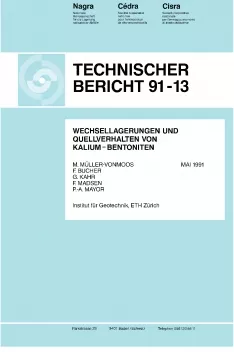
Technischer Bericht NTB 91-13
Wechsellagerungen und Quellverhalten von Kalium-Bentoniten
In order to assess the long-term stability of compacted bentonites under the conditions prevailing in a repository for high-level radioactive waste, natural potassium bentonites with defined pressure-temperature histories derived from geological studies were investigated. Ordovician potassium bentonites from Kinnekulle (Sweden) and Late Cretaceous bentonites from Montana (USA) were selected for the experiments. For comparison purposes, an illite from France and one from Hungary were also investigated. Careful separation of the grain size fraction < 0.2 μm of the potassium bentonites and analysis of the more or less pure mixed-layer components thus obtained gave 38 – 90 % mixed-layers and 2.4 – 4.9 % K2O as fixed potassium in the clay mineral structures. Based on the cation exchange capacity and the fixed interlayer potassium, interlayer charges of 0.38 to 0.47 charges per formula unit were calculated for the mixed-layers of the potassium bentonites. The interlayer charge calculated for the Kinnekulle sample B39 was confirmed experimentally after loading forty times with alkyl ammonium ions of chain length C6 – C14. Despite the heating effect following the formation of the bentonites, the interlayer charge of the potassium bentonites was only slightly increased and was still smectitic and, under the assumption of a starting material with 100 % swelling capacity, part of the swelling capacity remained intact. The swelling pressure measured for air-dried, uniaxially compacted samples with dry densities between 1.5 Mg/m3 and 2 Mg/m3 varied in the range 1 N/mm2 to 15 N/mm2. This corresponded to 10 – 70 % of the swelling pressure of a calcium bentonite (Montigel) with the same dry density. This showed that the Kinnekulle samples only reached their full swelling capacity after being dispersed ultrasonically. The effect of the ultrasonic treatment was generally much weaker for the Montana samples. The reasons for the restricted swelling in the case of the Kinnekulle samples are discussed.
The illite MC (Massif Central) from France had very high swelling pressures which, for low dry densities (1.4 – 1.7 Mg/m3), lay in the range of swelling pressures for the calcium bentonite Montigel. In contrast to the illite MC, the Hungarian illite S (Sarospatak) had much lower swelling pressures. Swelling pressures calculated from water vapour adsorption isotherms complemented the investigation programme.
